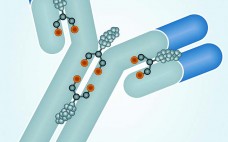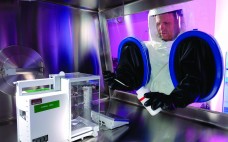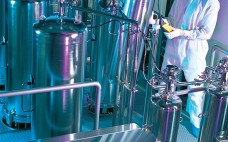Antibody–drug conjugates (ADCs) use the targeting ability of a monoclonal antibody (MAb) to deliver a highly biologically active drug to diseased cells while sparing healthy cells, creating potent and effective therapies. This emerging class of novel drugs currently focuses almost exclusively on cancer treatment. Two blockbuster ADCs — brentuximab vedotin (Adcetris from Seattle Genetics) for treatment of rare lymphomas and ado-trastuzumab emtansine (Kadcyla from Genentech/ Roche, manufactured by Lonza) for treatment of HER2-positive metastatic breast cancer — have improved treatment…
2014
Predicting Aggregation Propensity and Monitoring Aggregates in ADCs
Antibody–drug conjugates (ADCs) are monoclonal antibodies coupled to cytotoxic agents with stable linkers. ADCs travel to target cells, where the antibody binds to its antigen expressed on the cell surface. Upon binding, the full ADC can be internalized by a process called receptor-mediated endocytosis. That process is followed by lysosomal degradation of ADC complexes, which ultimately leads to release of the cytotoxic agent and apoptosis of the target cell. Drugs used in ADCs can be up to a thousand times…
Technology Advances Enable Creation of Better ADCs
Antibody–drug conjugates (ADCs) for treatment of cancer combine the tumor-targeting properties of antibodies with the cell-killing properties of cytotoxic drugs. By targeting a drug to a tumor, it is possible to reduce systemic toxicity and thereby enable administration of drugs that are otherwise too toxic to be effective therapies. Although the concept of an ADC is simple, in reality developing an effective treatment is somewhat more challenging. Whether an ADC has sufficient efficacy at a tolerable dose depends on four…
Using a CMO for Your ADC: Access Analytical and Manufacturing Platforms, Specialized Facilities, and Expertise
[Audio Recording] Antibody–drug conjugates (ADCs) are an exciting new area of therapeutics. They bring the “magic bullet” that was promised by Paul Ehrlich over a hundred years ago to reality by targeting cancer cells to deliver chemotherapies without poisoning a patient’s whole body. ADCs offer a promising form of therapy by providing higher safety margins than traditional chemotherapeutics alone, and they make selectivity possible. We should be able to personalize a therapy to the specific cancer expressed in a given…
October 2014 Issue Author Insights
Exclusive author commentary and article previews for the BioProcess International October 2014 issue.
From the Editors: BioProcess International Conference 2014 Producer Preview
Now in its 11th year, the BioProcess International Conference and Exhibition is the industry’s number-one event. At BPI you can make new connections in the field while strengthening current relationships. Network with the advisory committee and speakers, meet key industry contacts, share new ideas with poster presenters, and discover new technologies from exhibitors and sponsors. Participate in interactive sessions and discussions. This year’s program offers multiple new formats for sharing information and ideas. Networking: Join the partnering360 online network for…
Keynote Addresses
In literature and music, a keynote establishes the main underlying theme of a work of art. Think of the famous “da-da-da-DUM” in Beethoven’s 5th Symphony. Or in George Orwell’s Animal Farm: “All animals are equal, but some animals are more equal than others.” Similarly, a keynote address establishes the framework for program of events or convention agenda. Frequently the keynote speaker sets the underlying tone and summarizes the core message or most important revelation of an event. Some famous keynote…
Cell Culture and Upstream Processing
What’s on the minds of groups involved in cell culture and fermentation in 2014? They want to build on recent achievements in reducing timelines and cost-of-goods (CoGs) while increasing efficiency and productivity by implementing potentially disruptive approaches and technologies. Those include genomic tools and synthetic biology, continuous bioprocessing, single-use applications, process intensification, raw-material integrity test methods, culture media optimization approaches, technology transfer, and small-scale models. Raw Materials Matter: Culture media, supplements, and related ingredients are important raw materials in…
Recovery and Purification
What’s on the minds of groups involved with downstream processing in 2014? They want to capitalize on innovations in methodologies, materials science, and technologies to help optimize efficiencies. They’re using process design and flexibility in downstream processing to purify an emerging wave of antibodies and novel product modalities. They’re interested in disruptive harvest-step technologies, new chromatography chemistries, continuous processing and the interface between upstream and downstream, high-throughput technologies and modeling, sequence variant analysis, and improving flexibility and facility fit.…
Manufacturing Strategy
What’s on the minds of leaders involved in manufacturing and operations strategy in 2014? They want to maximize efficiencies and cost savings across their manufacturing networks by implementing potentially disruptive technologies, operational excellence and new facility concepts. But they also have to be flexible to the production needs of diverse pipelines in a multiproduct environment. New concepts in biomanufacturing can help companies reach those goals through technology transfer, scale-up/scale-down, continuous manufacturing, single-use applications, and possibly relaxing some biomanufacturing facility environmental…








